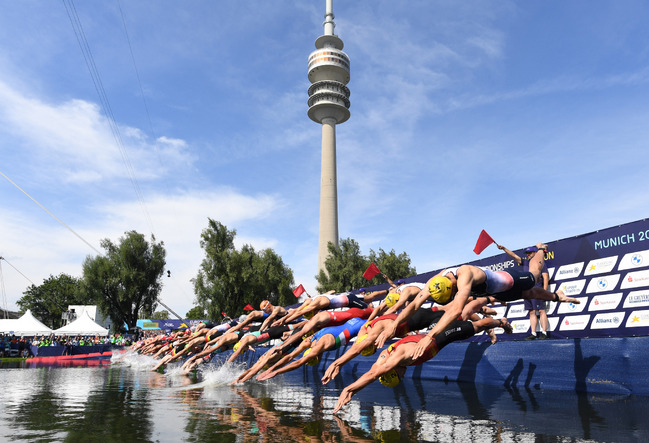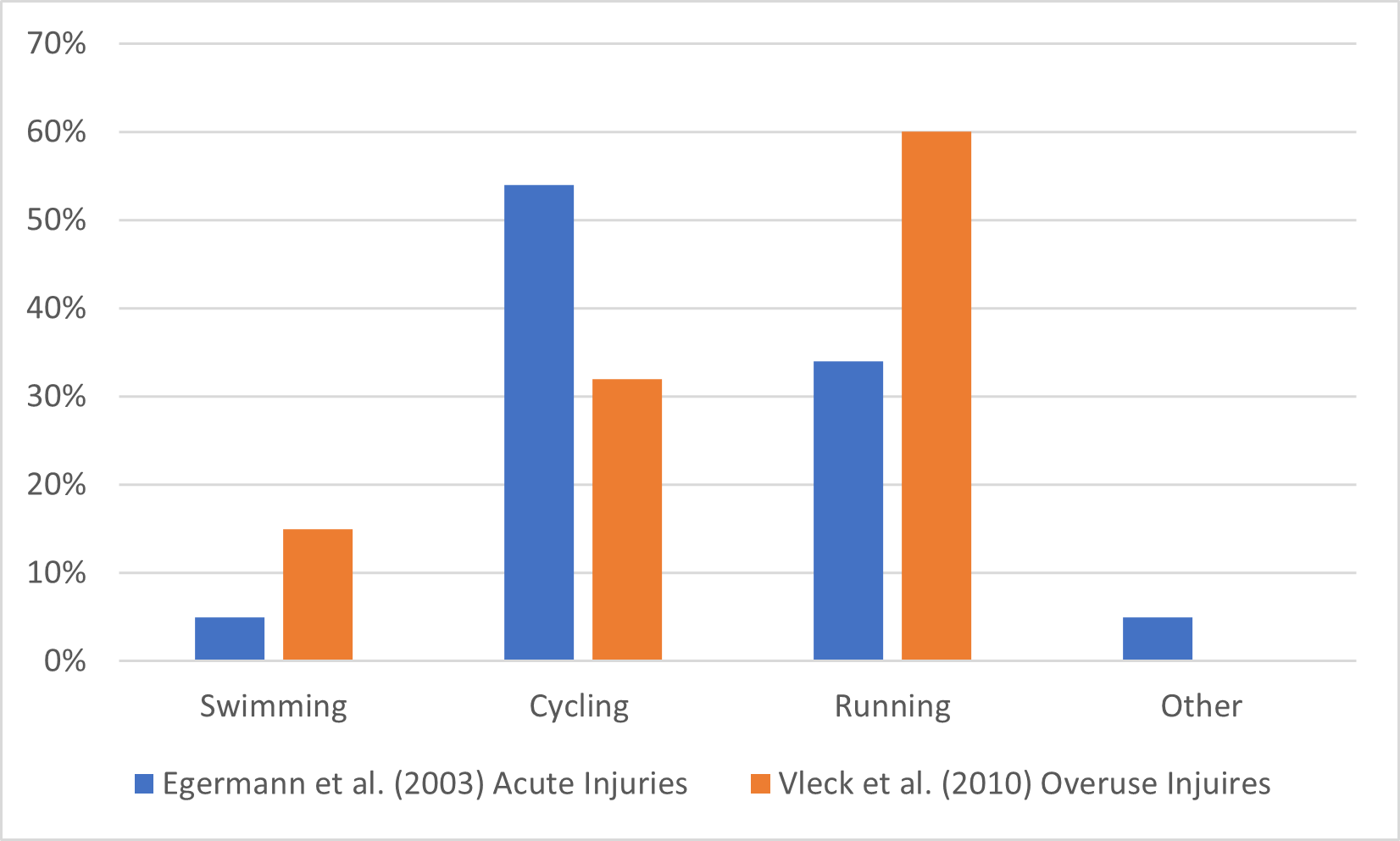You are viewing 1 of your 1 free articles
Balancing act: incidence and prevalence of triathlon injuries
Triathlons’ popularity continues to grow. As more athletes participate in the sport, researchers get greater insight into the incidence and prevalence of injuries to help design and implement injury prevention and management strategies. Andrew Berry discusses what is known thus far regarding injury incidence and prevalence in triathlons.
2022 European Championships – Triathlon - General view of athletes in action at the start of the Men’s Triathlon Elite Final REUTERS/Andreas Gebert
Triathlon comprises three different sports disciplines: swimming, cycling, and running. It has recently found a place in the spotlight globally and is a relatively young sport. The complex interplay between the three disciplines means that the risk factors predisposing triathletes to injury are not the same as the risk factors for each discipline in isolation. Understanding the intrinsic and extrinsic risk factors will aid coaches, athletes, and practitioners in creating individualized training, and injury management and prevention strategies for triathletes.
Triathletes train on average 10-14 hours a week. This comprises 8-10 training, which is higher than single-sport athletes and increases the injury risk. Therefore, having an injury prevention strategy aimed at triathletes could prove vital in the sport’s progression for amateurs, age-groupers, and elites. In addition, the popularity of the triathlon has created multiple competition formats. A triathlon can be completed over any distance, but the more common events are the Ironman, Half Ironman, and Olympic distances (see table 1).
Table 1: the most common triathlon distances
| Race type | Swim | Bike | Run | Total |
| Ironman | 3.8km | 180km | 42.2km | 226km |
| Half Ironman/70.3 | 1.9km | 90km | 21.1km | 113km (70.3m) |
| Olympic | 1.5km | 40km | 10km | 51.5km |
| Sprint | 750m | 20km | 5km | 25.75km |
Researchers in the United Kingdom conducted a systematic review of long-distance (Ironman) triathletes to determine the epidemiology of musculoskeletal injuries. The study results showed that elite athletes have a lower incidence of overuse and acute injuries than non-elite(1). The overuse injury incidence ranges between 37% and 91%, with elite athletes on the lower end of the range. When comparing the short (Olympic) and long (Ironman) distance athletes, the injury incidence is similar, with the knee being the most commonly affected area in both populations(2). Regarding the injury incidence within each discipline, running and cycling were the most frequently affected (see figure 1)(1).
When assessing the risk factors in triathlon, the accumulative stress of high-volume training increases the injury risk, and athletes commonly attribute the high load to their injuries(2). Therefore, coaches and practitioners must consider the interplay and accumulation of load when designing training, rehabilitation, and competition schedules.
Researchers at the School of Health Jean Piaget Algarve in Portugal conducted a study to identify the prevalence of injuries during training or competition in triathletes. The results showed a prevalence of 2.39 injuries per 1000 hours of training, with the primary mechanism of injury being overtraining. The researchers noted that 14 injuries occurred during swimming, 23 during cycling, and 93 during running(3). Soft tissue muscle injuries (31.5%) were the most common injury, followed by inflammatory injuries (19.2%), tendinopathy (16.2%), then ligament injuries (15.4%) (see figure 2). The results show that running conditioning and technique could play a more significant role in injury prevention strategies and needs to be considered when planning training programs.
Due to the different intensities between competition and training, competition has a 6-fold increase in all injuries amongst long-distance triathletes, with an increased acute injury incidence per 1000 hours of competition(4).
There is a clear positive correlation between time spent training and the incidence of injury. Still, the fact that elite athletes have lower injury rates suggests that the quality of training influences injury rates(1). This further emphasizes the importance of having triathlon-specific coaching and health professionals that understand the sport.
The most common extrinsic cause of injuries in triathlon is inadequate equipment(3). Although extrinsic factors are often uncontrollable, in the case of the athlete’s equipment, coaches and practitioners need to be involved and advise the athlete on what equipment should be renewed or set up differently. The most common extrinsic factor that could prevent injuries on the cycle would be bicycle setup and, on the run, would be the mileage on the shoes(3).
Training and strength program periodization is currently the generalized approach to help prevent injuries for triathletes and other cardiovascular sports(6). However, specific research on triathletes is lacking. With a better understanding of how they differ from other sporting codes, coaches and practitioners will move one step closer to creating effective injury prevention protocols specific to the demands. However, there is ample evidence to suggest that strength training effectively prevents athletes from getting injured.
Conclusion
When assessing the injury risk in triathlons, running is where most injuries occur, especially overuse injuries. Prevention programs need to target the run phase and create the capacity transition from low-impact cycling to high-impact running after the second transition. Strength training is often neglected in the world of endurance sports and could also be an effective answer to decreasing running injuries. Optimal loading and program adherence by the athlete also become vital in preventing injury.
References
1. J Hum Kinet, 2022, 81(1), pp.123–134
2. J Strength Cond Res. 2010;24(1):30–36
3. Rev. Assoc. Med Bras, 2020, 66(11), pp.1536–1541
4. Acta Ortop Bras. 2014;22(4):191-6
5. Br J Sports Med. 2013;47(13):857–861
Newsletter Sign Up
Subscriber Testimonials
Dr. Alexandra Fandetti-Robin, Back & Body Chiropractic
Elspeth Cowell MSCh DpodM SRCh HCPC reg
William Hunter, Nuffield Health
Newsletter Sign Up
Coaches Testimonials
Dr. Alexandra Fandetti-Robin, Back & Body Chiropractic
Elspeth Cowell MSCh DpodM SRCh HCPC reg
William Hunter, Nuffield Health
Be at the leading edge of sports injury management
Our international team of qualified experts (see above) spend hours poring over scores of technical journals and medical papers that even the most interested professionals don't have time to read.
For 17 years, we've helped hard-working physiotherapists and sports professionals like you, overwhelmed by the vast amount of new research, bring science to their treatment. Sports Injury Bulletin is the ideal resource for practitioners too busy to cull through all the monthly journals to find meaningful and applicable studies.
*includes 3 coaching manuals
Get Inspired
All the latest techniques and approaches
Sports Injury Bulletin brings together a worldwide panel of experts – including physiotherapists, doctors, researchers and sports scientists. Together we deliver everything you need to help your clients avoid – or recover as quickly as possible from – injuries.
We strip away the scientific jargon and deliver you easy-to-follow training exercises, nutrition tips, psychological strategies and recovery programmes and exercises in plain English.













